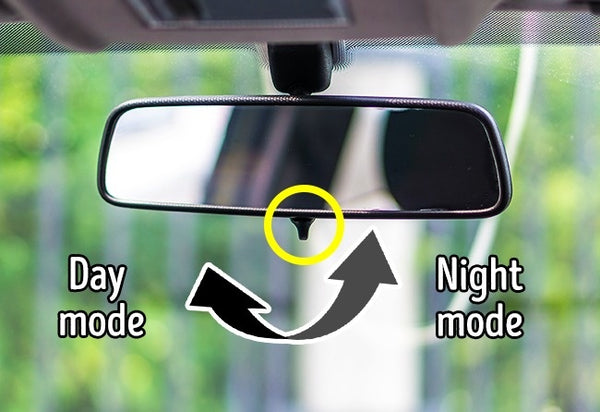How Do Day/Night Rear View Mirrors Work?
How Day/Night Rear View Mirrors Improve Visibility and Safety
Navigation
- Day And Night Rear View Mirrors –How They Work
- The Idea Behind Using Day And Night Rear View Mirrors
As much as driving your car feels liberating and pleasant, there comes a number of safety concerns while you are on road, especially when driving along a highway or a busy city road. The car rear view mirror above the dashboard is undoubtedly one of the most major parts of the car while driving because this tool alone can tell you about the traffic behind you i.e. act like your third eye behind your head.
While at first glance, the rear view reflected on the mirror might look like a simple act of reflection and refraction, the complication rises when you are driving under scorching sun or ahead of extra bright headlights flashing from another car.

In both these cases, the sharp light reflected on a normal mirror would be almost blinding but the electrochromatic or mirrors with dimming effects are different. These mirrors make sure that the light is refracted at such an angle that you n either have to worry about the sun during day or the bright headlights behind your car.
So, what exactly is the function of these dimming mirrors on the dashboard? Have a look.
Day And Night Rear View Mirrors –How They Work
First things first, these convex rear view mirrors for rear view of the cars appear to be straightly placed but in real, they are placed at an angle with the mirrored surface and are called prismatic wedge. The wedge of glass is placed at an angle with the mirror. This makes sure that any bright light coming from a rear source is refracted indirectly to your eyes so that you see a dimmed light rather than the flashy light.

However, things change when you are driving in dark and a car just happens to flash the headlights behind you. The incoming light, in this case gets refracted directly to your eyes as you drive and often create a blind spot, which can be fatal especially if there is a vehicle ahead and your vision is temporarily blinded. In such cases, you can easily flip the mirror upward to reverse the reflection.
However, Campark brings you the Front and Rear Mirror Dash Cam with backup camera and dash camera so that there is no need of manually flip the mirror as the electrochromatism effect automatically dims the incoming light both during day and night. It has the latest WDR or Wide Dynamic Range feature for the camera that fine tunes the reflections according to light conditions and therefore, the reflection you see is neither to bright nor too dim.
The Idea Behind Using Day And Night Rear View Mirrors
A simple mirror for monitoring rear view is too conventional especially when accidents often take place and not everyone is a responsible driver. The car camera incorporated with the rear view mirrors make sure that only 4% incoming light reflection is seen by the driver in daytime and you can change the mirror tab at night to avoid bright light from blinding your otherwise sensitive night vision with dilated pupils.

The dimming effect both during day and night makes the bright lights bounce off from your vision and let dimmed light give your eyes comfort.
The special night rear view mirrors can help the driver avoid the headlights on the opposite side, and will not make you feel very dazzling and clear. There are many kinds of night rear view mirrors, the price is also the same, the effect is also different.
Night rear view mirrors technology is a photoelectric technology that realizes night observation by means of photoelectric imaging devices. Night rear view mirrors include low-light night vision and infrared night vision. Low-light night vision technology, also known as image enhancement technology, is a photoelectric imaging technology that uses night vision goggles with image intensifier tubes to enhance the weak target image illuminated by night light for observation. Low-light-level night vision is currently the largest and most widely used night vision equipment in foreign countries. It can be divided into direct observation (such as night vision observers, weapon sights, night pilots, night vision glasses) and indirect Observation (such as low-light TV) two kinds. Infrared night vision technology is divided into active infrared night vision technology and passive infrared night vision technology. Active infrared night vision technology is a night vision technology that implements observation by actively irradiating and using infrared light reflected by the target to reflect the infrared source.

The corresponding equipment is an active infrared night vision device. Passive infrared night vision technology is an infrared technology that uses the infrared radiation emitted by the target itself to achieve observation. It finds the target according to the temperature difference or thermal radiation difference between the target and the background or parts of the target. Its equipment is a thermal imager. Thermal imaging cameras have unique advantages different from other night vision devices, such as being able to work in fog, rain, and snow, having a long range, being able to recognize camouflage and anti-interference, etc.
It has become the focus of foreign night vision equipment development, and It will replace the low-light night vision device to a certain extent.
Read More
- Trail Camera introduction|Trail Camera Einführung – Campark - Focus on Cameras
- Trail camera Customer feedback video – Campark - Focus on Cameras
- About trail camera|Über Wegkamera – Campark - Focus on Cameras
- Go-To Black Friday Deals of 2021 – Campark - Focus on Cameras
- Campark solar panels review and application – Campark - Focus on Cameras
